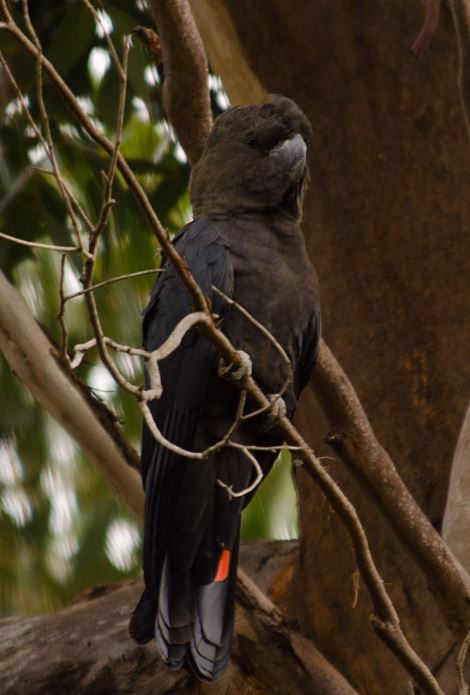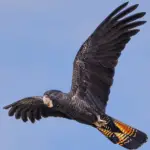
Glossy Black-Cockatoo: 46–50 cm; c. 450 g; female smaller. Smallest black cockatoo, which, together with lack of a distinctive crest distinguishes present species from C. banksii.
Brownish black overall with the red subterminal panel in the tail, narrower than in C. banksii; outer vane of outermost rectrix black; dark grey bill, with upper mandible bulbous and lower mandible broad and hollowed at tip; feet grey.
Glossy Black-Cockatoo female has yellow patches on head and sides of neck; tail panel red and yellow barred black, with central two feathers all black.
Immature like the adult female, but with yellow body barring on throat and belly during the first year. Race halmaturinus has a disproportionately larger bill than that of nominate, whilst Erebus has a smaller one.
Calyptorhynchus lathami Scientific name definitions
- LC Least Concern
- Names (15)
- Subspecies (3)
Systematics History
Editor’s Note: This article requires further editing work to merge existing content into the appropriate Subspecies sections. Please bear with us while this update takes place.
Three subspecies were recognized.
Subspecies
SUBSPECIES
Calyptorhynchus lathami erebus Scientific name definitions
Distribution
coastal CE Queensland, in E Australia.
SUBSPECIES
Calyptorhynchus lathami lathami Scientific name definitions
Distribution
inland and coastal E Australia from SE Queensland to E Victoria.
SUBSPECIES
Calyptorhynchus lathami halmaturinus Scientific name definitions
Distribution
Kangaroo I (South Australia).
Distribution
Editor’s Note: Additional distribution information for this taxon can be found in the ‘Subspecies’ article above. In the future, we will develop a range-wide distribution article.
Habitat
Dependent on sheoaks (Allocasuarina) in coastal forest and open woodland in E and SE Australia.
Movement
Glossy Black-Cockatoo follows fruiting trees around a locality throughout the year; usually in small groups but up to 40 birds may roost together.
Glossy Black-Cockatoo Encounter
SOURCE: Werrong Lane
Diet and Foraging

Appears to feed almost exclusively on the seeds of Allocasuarina species (A. verticillata, A. littoralis, A. torulosa). Cones are picked individually and fragmented in the specialized bills to release seeds;
these are then separated by working tongue and lower mandible against upper mandible and discarding the chaff; cone-handling time is 40–140 seconds, depending on the size of the cone.
Sounds and Vocal Behavior
Not very vocal. The commonest call is a drawn-out grating “krrrrruh”, given both in flight and when perched. When foraging, softer call notes are uttered such as “kruh” or “kree”.
Breeding
Mar–Aug. Nest is a bed of chips in a large hollow of a dead or live tree. glossy black cockatoo eggs; 1 egg (occasionally 2); incubation c. 29 days, by female only; chick has long, dense yellow down; male feeds female which then feeds nestling;
young bird leaves nest when 60–100 days old. In race halmaturinus, 1·2–1·6 adult males per female during 1996–2011, with a similar sex ratio in nestlings.
glossy black cockatoo price
Like most cockatoo species, the Glossy Black-Cockatoo is protected by the Convention on International Trade in Endangered Species of Wild Fauna and Flora ( CITES ), with its inclusion on the Appendix II list of vulnerable species, which makes the import, export, and trade in wild-caught animals illegal. Therefore, its price is more than 20,000$
Conservation Status
Not globally threatened (Least Concern). Formerly considered Vulnerable. CITES II. Rare and unobtrusive, and not widely known; historically, has suffered extensive habitat loss.
Many areas of suitable habitat are now protected in reserves and parks, but, with species’ very specialized dietary requirements, local populations could become endangered if the supply of Allocasuarina were to fail; care in ensuring continuing replacement of food trees is important. Race halmaturinus

of Kangaroo I is endangered; it numbers fewer than 200 birds with only a small breeding population that has to compete for hollows with brush-tailed possums (Trichosurus vulpecula), honey bees (Apis mellifera), and the more aggressive Eolophus roseicapilla; a study of this race is in progress,
to identify and suggest remedies for current very poor recruitment rate. Plantings of drooping casuarina (Allocasuarina verticillata), the prime food source, established only 10 years ago, are already bearing cones and attracting present species to feed.




















